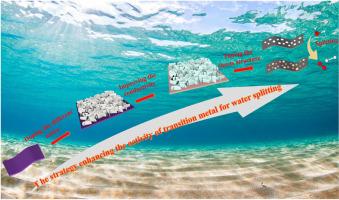Developing Schottky high-controductivity Ti3C2TX MXene/Ni2P/NF heterojunction with modulating surface electron density to boost hydrogen evolution reaction
IF 8.3
2区 工程技术
Q1 CHEMISTRY, PHYSICAL
引用次数: 0
Abstract
Nickel-based transition metal electrocatalysts for water electrolysis are promising alternatives to precious metal based electrocatalysts, due to their high activity, low cost, and relatively high stability, offering broad prospects for application in hydrogen production via water electrolysis. Modifying nickel-based transition metal electrocatalysts with phosphorus elements and Schottky heterojunction interfaces can influence the electronic state of the metal, thus enhance the electrocatalytic performance of the catalyst. In this study, a phosphor modified nickel-based electrocatalyst, i.e. MXene/Ni2P/NF electrode material was obtained by assembling Ni2P nanosheets on a nickel foam (NF) substrate and then depositing MXene nanosheets onto the surface of Ni2P/NF via electrophoretic deposition. Water droplets can wet the interior of the electrode material within 150 ms (below the detection limit), demonstrating excellent hydrophilicity, which facilitates the wettability of the electrolyte and the adsorption/desorption of reaction intermediates. Electrochemical tests revealed that the MXene/Ni2P/NF electrode exhibits an overpotential of only 94 mV at a current density of 10 mA cm−2, with a Tafel slope of 83.7 mV dec−1, in the hydrogen evolution reaction. The overpotential remains virtually unchanged after a 24-h stability test.

开发具有调节表面电子密度的肖特基高导电率 Ti3C2TX MXene/Ni2P/NF 异质结,促进氢气进化反应
用于水电解的镍基过渡金属电催化剂具有活性高、成本低和相对较高的稳定性等优点,是贵金属电催化剂的理想替代品,在水电解制氢领域具有广阔的应用前景。用磷元素和肖特基异质结界面修饰镍基过渡金属电催化剂可以影响金属的电子状态,从而提高催化剂的电催化性能。本研究通过在泡沫镍(NF)基底上组装 Ni2P 纳米片,然后通过电泳沉积将 MXene 纳米片沉积到 Ni2P/NF 表面,得到了磷修饰的镍基电催化剂,即 MXene/Ni2P/NF 电极材料。水滴可在 150 毫秒内润湿电极材料内部(低于检测限),显示出极佳的亲水性,这有利于电解质的润湿性和反应中间产物的吸附/解吸。电化学测试表明,在氢进化反应中,MXene/Ni2P/NF 电极在电流密度为 10 mA cm-2 时的过电位仅为 94 mV,塔菲尔斜率为 83.7 mV dec-1。经过 24 小时的稳定性测试后,过电位几乎保持不变。
本文章由计算机程序翻译,如有差异,请以英文原文为准。
求助全文
约1分钟内获得全文
求助全文
来源期刊

International Journal of Hydrogen Energy
工程技术-环境科学
CiteScore
13.50
自引率
25.00%
发文量
3502
审稿时长
60 days
期刊介绍:
The objective of the International Journal of Hydrogen Energy is to facilitate the exchange of new ideas, technological advancements, and research findings in the field of Hydrogen Energy among scientists and engineers worldwide. This journal showcases original research, both analytical and experimental, covering various aspects of Hydrogen Energy. These include production, storage, transmission, utilization, enabling technologies, environmental impact, economic considerations, and global perspectives on hydrogen and its carriers such as NH3, CH4, alcohols, etc.
The utilization aspect encompasses various methods such as thermochemical (combustion), photochemical, electrochemical (fuel cells), and nuclear conversion of hydrogen, hydrogen isotopes, and hydrogen carriers into thermal, mechanical, and electrical energies. The applications of these energies can be found in transportation (including aerospace), industrial, commercial, and residential sectors.
文献相关原料
公司名称
产品信息
阿拉丁
NaH2PO2
阿拉丁
KOH
 求助内容:
求助内容: 应助结果提醒方式:
应助结果提醒方式:


